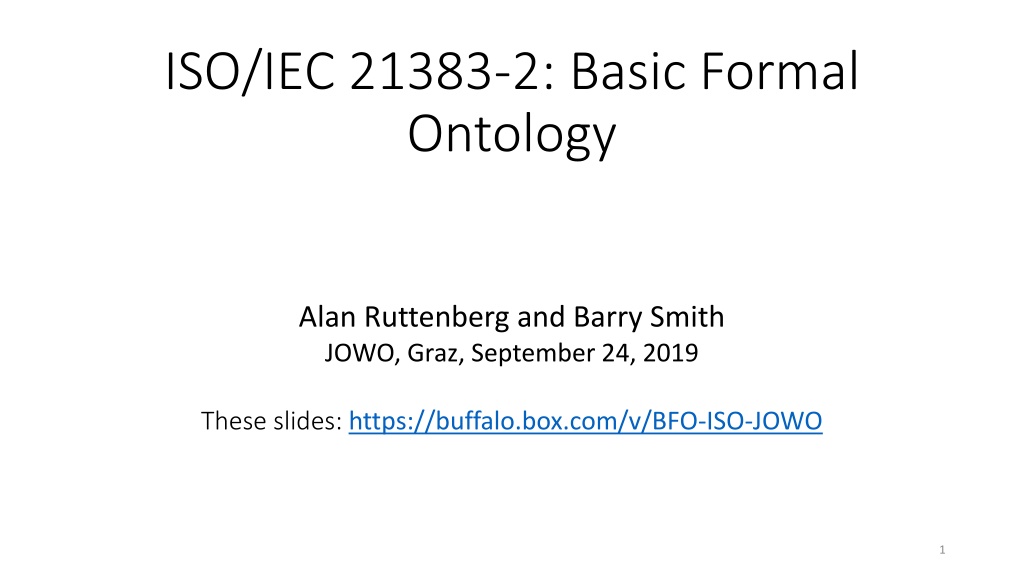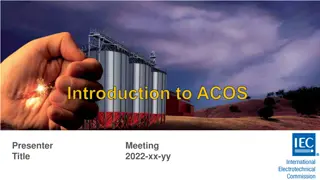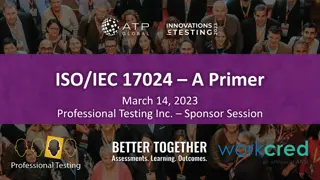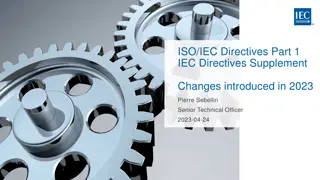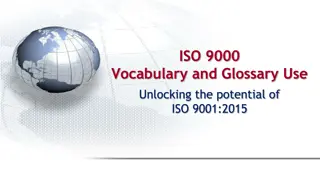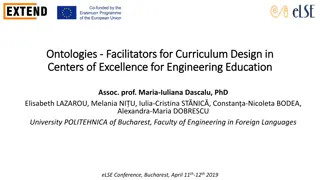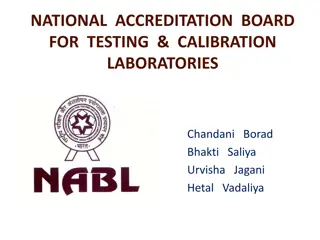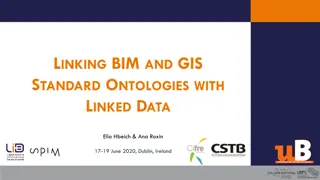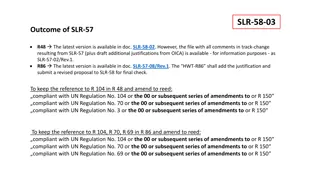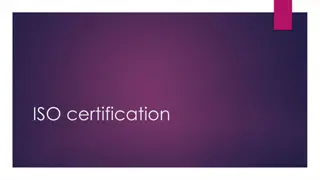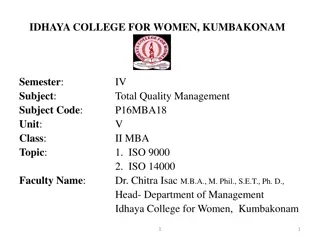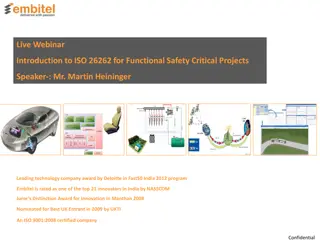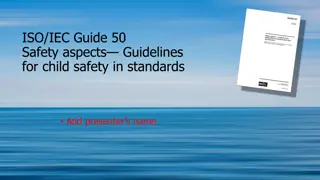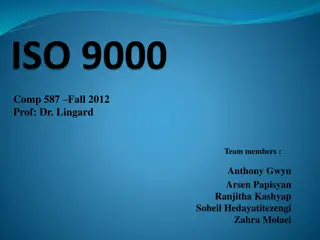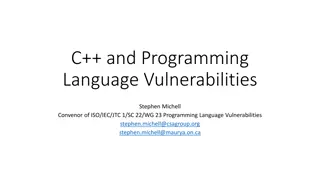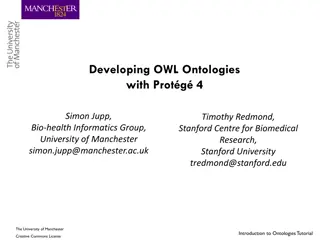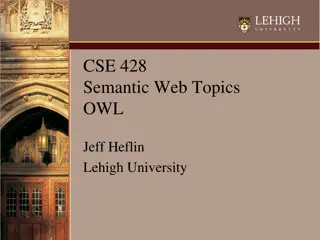Understanding ISO/IEC Standards and Ontologies in Information Technology
Exploring the world of ISO/IEC standards and formal ontologies as presented by Alan Ruttenberg and Barry Smith at JOWO Graz in 2019. The slides cover topics such as basic formal ontology, connectors, domain ontologies, top-level ontologies, and the requirements for being a top-level ontology. ISO/IEC standards and the role of the International Standards Organization (ISO) and International Electrotechnical Commission (IEC) are also discussed.
Download Presentation

Please find below an Image/Link to download the presentation.
The content on the website is provided AS IS for your information and personal use only. It may not be sold, licensed, or shared on other websites without obtaining consent from the author. Download presentation by click this link. If you encounter any issues during the download, it is possible that the publisher has removed the file from their server.
E N D
Presentation Transcript
ISO/IEC 21383-2: Basic Formal Ontology Alan Ruttenberg and Barry Smith JOWO, Graz, September 24, 2019 These slides: https://buffalo.box.com/v/BFO-ISO-JOWO 1
International Standards Organization (ISO) International Electrotechnical Commission (IEC) 2
International Standards Organization (ISO) International Electrotechnical Commission (IEC) ISO/IEC Joint Technical Committee JTC1: Information technology 5
iso.org/standard/71954.html iso.org/standard/74572.html 6
iso.org/standard/71954.html iso.org/standard/74572.html 7
ISO 21838-1: 3.14, 3.17 and 3.18 ontology =def. collection of terms, relational expressions and associated natural-language definitions together with one or more formal theories designed to capture the intended interpretations of these definitions domain =def. collection of entities of interest to a certain community or discipline domain ontology =def. ontologywhose terms represent classes or types in some domain 8
ISO 21838-1: 3.19 and 3:20 category =def. general class or type that is shared across many different domains and is represented by a domain-neutral term top-level ontology (TLO) =def. ontology that is created to represent the categories that are shared across a maximally broad range of domains 9
Requirements for being a top-level ontology Shall include no domain-ontology content (contra SUMO) Shall cover all entities (be maximally general) Shall comprise a collection of three information artefacts: 1. textual artefact 2. OWL axiomatization 3. CL axiomatization 10
Requirements for being a top-level ontology Quantities and mathematical entities Processes and events Constitution Causality Information and reference Artefacts and socially constructed entities Mental entities; imagined entities; fiction; mythology; religion Shall cover all entities Space and time Actuality and possibility Classes and types Time and change Parts, wholes, unity and boundaries Space and place Scale and granularity Qualities and other attributes 11
Requirements for being a top-level ontology Shall cover all entities (be maximally general) Shall comprise a collection of three information artefacts: 1. textual artefact 2. OWL axiomatization 3. CL axiomatization 12
Requirements for being a top-level ontology 1. exists as a textual artefact A TLO shall include a textual artefact represented by a natural language document providing: (1) a list of domain-neutral terms and relational expressions, incorporating identification of primitive terms, and (2) definitions of the meanings of the terms and relational expressions listed. 13
Requirements for being a top-level ontology 2. OWL axiomatization The TLO shall be made available via at least one machine- readable axiomatization in OWL 2 with the direct semantics [9] or in some description logic that is designated by W3C as a successor of OWL 2. The signature of the OWL axiomatization shall a subset of the set of natural language terms and relational expressions that is specified in the textual artifact. 14
Requirements for being a top-level ontology 3. CL axiomatization The TLO shall be made available via an axiomatization in a language conforming to ISO/IEC 24707 Common Logic [1]. The axiomatization shall be proven consistent using standard automated theorem provers. It shall be shown that BFO-ISO-OWL is derivable from BFO-ISO-CL How will CL help? 15
Infectious Disease Ontology (IDO) infectious organism =def. An organism that has an infectious disposition can be expressed in OWL 16
infectious disposition (5-place relation) =def. A pathogenic disposition that inheres in an organism and is a disposition for that organism (1)to be transmitted to a host, (2) to establish itself in the host, (3) to initiate processes that result in a disorder in the host, and (4) to become part of that disorder. 17
infection (8-place relation) =def A part of an extended organism that itself has as part a population of one or more infectious agents and that (1) exists as a result of processes initiated by members of the infectious agent population and is (2) clinically abnormal in virtue of the presence of this infectious agent population, or (3) has a disposition to bring clinical abnormality to immunocompetent organisms of the same species as the host through transmission of a member or offspring of a member of the infectious agent population. 18
Documentation of hub and spokes approach to the creation of suites of interoperable ontology modules hub
Contents of ISO/IEC 21838-2: BFO Textual artifact (terms, relational expressions, definitions) Demonstration of status as top-level (= domain-neutral) ontology Link to OWL and CL content on ISO 389 Software Maintenance Portal (currently at https://buffalo.app.box.com/v/bfo-iso-owl-cl) Guide to creation of BFO-conformant ontology content 22
https://buffalo.app.box.com/v/bfo-iso-owl-cl OWL 1. bfo-iso.owl OWL in rdf/xml format 2. bfo-iso.ofn OWL in a variant of a functional syntax with URIs 3. bfo-iso-labeled.ofn bfo-iso.ofn with the URIs replaced with the associated labels, a version more appropriate for reading Two versions provided, one with full set of temporalized relations 24
https://buffalo.app.box.com/v/bfo-iso-owl-cl MODEL three versions of the model used to prove consistency of the CL formalization: in prover 9, CLIF, and Clausetester formats CL CL axiomatization of BFO-ISO PDF complete set of modules of the CL axiomatization of BFO-ISO is provided in the traditional first-order logic (FOL) syntax. 25
entity BFO-ISO is a continuant occurrent independent continuant generically dependent continuant specifically dependent continuant process process boundary temporal region spatiotemporal region material entity quality realizable entity history immaterial entity zero-dimensional temporal region one-dimensional temporal region relational quality temporal instant temporal interval disposition object aggregate role fiat object part object site continuant fiat boundary spatial region function zero-dimensional spatial region one-dimensional spatial region two-dimensional spatial region three-dimensional spatial region fiat point fiat line fiat surface 26
BFO 2.0 27
entity BFO-ISO is a continuant occurrent independent continuant generically dependent continuant specifically dependent continuant process process boundary temporal region spatiotemporal region material entity quality realizable entity history immaterial entity zero-dimensional temporal region one-dimensional temporal region process profile X relational quality temporal instant temporal interval N disposition object aggregate role fiat object part object N site continuant fiat boundary spatial region function R R R zero-dimensional spatial region one-dimensional spatial region two-dimensional spatial region three-dimensional spatial region fiat point fiat line fiat surface X = Deprecated; N = New, R = Renamed 28
Other changes 1. Bug fixes, including improved set of natural-language definitions 2. FOL / CL formalization and consistency proof More expressive, more intuitive for human use in ontology design Provides basis for multiple different OWL versions BFO-ISO-OWL1 core version BFO-ISO-OWL2 version with full set of temporalized relations 29
Rollout strategy for BFO-ISO 1. Publication of ISO/IEC 21838 Parts 1 and 2 in spring 2020 2. Revise BFO 2.0 Spec to conform to BFO-ISO and publish for critical review 3. Replace BFO 2.0 by BFO-ISO as official version of BFO 4. Create software to enable (semi-)automatic update of BFO 2.0-based ontologies to BFO-ISO conformance 30
Initial impact ISO 29303: Interoperability Reference Framework ISO/CEN Materials Testing Joint AI Center (JAIC) ISO standard for AI IC and Military Ontology Suites BFO-Based Engineering Ontologies - NCOR Wiki IOF 31
Next steps with BFO 1. Sites protein sites, oral cavity, thoracic cavity, [interior of] exhaust pipe vs. spatial regions (determined by frame of reference) 2. Units of measure how to deal with things like this. What sort of entity is a joule per second squared (1 m2kg / s4)? 3. What is a system in BFO? 4. Process qualities BFO recognizes only qualities of independent continuants what about rates (heart beat, flow, frequency, ). What about qualities of processes as recognized by PATO (the quality ontology) For example: velocity, frequency, rate (of heart beat, of flow) 38
specifically_depends_on Occurrent Continuant process, event Specifically Dependent Continuant Independent Continuant .... ..... ....... temperature depends on bearer thing quality 39
The problem with process qualities Occurrent (Process) Independent Continuant (molecule, cell, organ, organism) inheres-in inheres-in quality rate ..... ..... .... ..... 40
The problem with process qualities Occurrent (Process) Independent Continuant (molecule, cell, organ, organism) inheres-in inheres-in PATO: quality ..... ..... .... ..... 41
Proposed solution Occurrent (Process) Independent Continuant (molecule, cell, organ, organism) has-characteristic inheres-in BFO: quality PATO: characteristic ..... ..... .... ..... 42
characteristic is an abbreviation (defined class, convenience class) John is running at 3 miles per minute at t means: John has quality at t: running at 3 miles per minute John participant_in running r1 at t r1 has characteristic (rate) 3 miles per minute at t 43
characteristic is an abbreviation (defined class, convenience class) Example: running r at t has velocity v r has characteristic (rate) v at t =def. there is some x, x is an independent continuant & x participant_in r at t & x has quality at t: running at 3 miles per minute 44
Continuant Occurrent Specifically Dependent Continuant Independent Continuant Realizable Dependent Continuant Quality Disposition Role Function e.g. Functioning 45
Specifically Dependent Continuant Independent Continuant Occurrent Realizable Dependent Continuant Quality Disposition Role e.g. Disease Function Disease Course 46
Specifically Dependent Continuant Independent Continuant Occurrent Realizable Dependent Continuant Quality Disposition Role e.g. Disease Function has material basis realized in Disease Course Disorder 47
Specifically Dependent Continuants if any bearer ceases to exist, then the quality or function ceases to exist Specifically Dependent Continuant the color of my skin the function of my heart Realizable Dependent Continuant Quality, Pattern 48
Generically Dependent Continuants Generically Dependent Continuant if one bearer ceases to exist, then the entity can survive, because there are other bearers (copyability) Information Object Sequence the pdf file on my laptop the DNA (sequence) in this chromosome 49
Information objects pdf file poem symphony algorithm symbol sequence molecular structure 50
